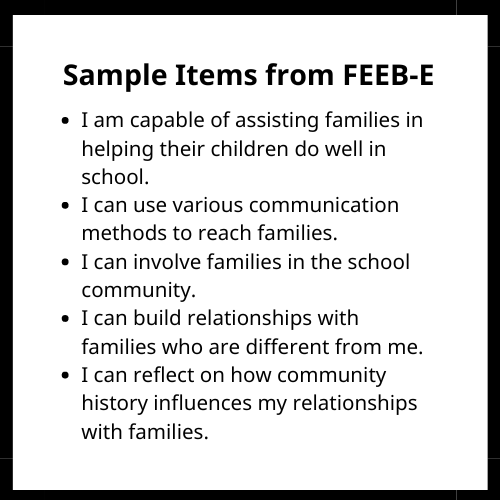
By Dr. Hadley F. Bachman
What special talent do you have? It could be anything: fly-fishing, baking a perfect pie crust, reading subway maps, or hula-hooping. Whatever it is, you developed that skill, starting with an initial good experience and expanding your repertoire by learning from wins and losses. The belief in one’s own agency or capacity to accomplish a particular task is called self-efficacy. One’s efficacy beliefs affect how hard someone tries, how much they persist in the face of difficulties, and ultimately, how likely they are to succeed.
For over twenty years, research has underscored the importance of understanding efficacy for teaching. Efficacy is linked to a willingness to try new techniques and persist through difficulties, resulting in improved teaching and better student outcomes. However, until recently, we didn’t have a measure of educators’ efficacy beliefs about engaging with students’ parents/caregivers, which is crucial because strong family engagement can significantly enhance student learning and success. I set out to change that. I defined family engagement efficacy beliefs as how capable an educator believes they are of doing what it takes to partner with families for improving instruction and student learning.
In 2022, the National Association for Family, School, and Community Engagement published the Family Engagement Core Competencies, which includes skills such as building relationships, embracing equity, and advocating for systems change. These eight competencies represent what educators do when partnering with families to promote child and youth success in school and beyond and support schools and communities in becoming more equitable and just places. I used them as the basis for creating a survey measure called the Family Engagement Efficacy Beliefs of Educators (FEEB-E).
The final version of the FEEB-E consists of 20 items. Respondents rate themselves from “very untrue of me” to “very true

of me” on items such as, “I can use various communication methods to reach families.” See the box for other examples. The survey takes about five minutes, and once finished, respondents receive personalized scores highlighting their highest and lowest aspects of family engagement efficacy. It is freely available for use by individual educators to identify areas where they feel most and least confident about engaging with families.
Educational leaders can use the FEEB-E to:
- Assess the strengths and growth areas in the family engagement efficacy beliefs of their staff, helping them tailor professional learning to meet the specific needs of their team. For example, if the FEEB-E reveals a lack of confidence in using data to assess family engagement, leaders might organize professional development about goal-directed family engagement and measuring impact through student data outcomes.
- Track changes in efficacy beliefs; administering the FEEB-E at regular intervals, such as once per semester, can help evaluate the impact of professional learning initiatives, mentoring programs, or other efforts.
- Compare practices across grade levels or buildings to identify educators with strong efficacy beliefs in particular areas. For example, if one elementary school in a district shows high efficacy beliefs for communication, a review of practices in that building can reveal action steps for the district as a whole.
- Identify pockets of success to help replicate effective practices and highlight potential mentors.
To ensure honest responses, educational leaders should clearly communicate the purpose of using the FEEB-E and reassure staff about procedures to maintain confidentiality. For example, educational leaders receive aggregate responses, safeguarding the confidentiality of individuals. The FEEB-E should not be used for decisions about individual job performance evaluations.
The Family Engagement Efficacy Beliefs of Educators (FEEB-E) Survey is copyrighted by Dr. Hadley F. Bachman (2023). School districts may request a district version of the FEEB-E. The FEEB-E is also freely available for research use, with permission. Contact Dr. Bachman about district surveys or research.
Photo from: Canva
